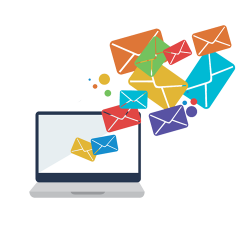Digital Marketing
Email Marketing
Email marketing is a form of digital marketing that involves sending commercial messages or promotional content to a group of people via email. It is a direct and targeted approach to reach and engage with your audience, build relationships, and drive conversions.
Here are some key points to consider when it comes to email marketing:
-
Building an Email List: Start by building an email list of people who have willingly opted in to receive communication from you. You can collect email addresses through website sign-up forms, social media campaigns, or offline events. It's important to obtain permission and ensure compliance with data protection regulations such as GDPR (General Data Protection Regulation).
-
Email Service Provider (ESP): Choose a reliable email service provider that offers features like list management, email template creation, scheduling, tracking, and analytics. Some popular ESPs include Mailchimp, AWeber, Constant Contact, and Sendinblue.
-
Segmentation and Personalization: Divide your email list into segments based on various criteria such as demographics, past purchases, or engagement levels. This allows you to tailor your content to specific audience segments and improve the relevance of your emails. Personalize your emails with recipient names and other relevant details to make them more engaging and personalized.
-
Compelling Content: Craft compelling and relevant content for your email campaigns. This can include product updates, special offers, newsletters, educational content, or event invitations. Make sure your emails provide value to your subscribers and are not overly promotional to avoid being marked as spam.
-
Design and Layout: Create visually appealing and mobile-responsive email templates that are easy to read and navigate. Use a combination of text, images, and call-to-action buttons to guide recipients towards desired actions.
-
Testing and Optimization: Test different elements of your emails, such as subject lines, content, layouts, and sending times, to optimize your campaigns. A/B testing can help you understand what resonates best with your audience and improve your email performance.
-
Email Automation: Utilize automation features to set up triggered email sequences based on specific actions or time intervals. Examples include welcome emails for new subscribers, abandoned cart reminders, or post-purchase follow-ups. Automation can save time and improve engagement.
-
Analyze and Track Results: Monitor key email marketing metrics like open rates, click-through rates, conversion rates, and unsubscribe rates. Use these insights to refine your strategies and improve future campaigns.
-
Compliance and Permissions: Ensure compliance with relevant email marketing laws and regulations, such as CAN-SPAM Act (in the United States) or GDPR (in the European Union). Provide clear options for subscribers to unsubscribe or manage their preferences.
Remember, successful email marketing involves providing value to your subscribers, maintaining a healthy sender reputation, and respecting their privacy and preferences. It's a powerful tool when used effectively to build relationships, drive sales, and nurture customer loyalty.

